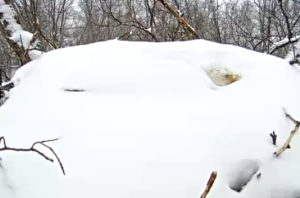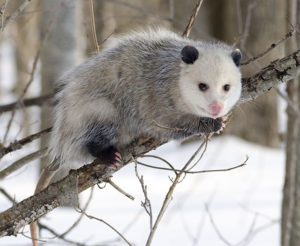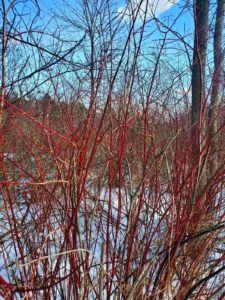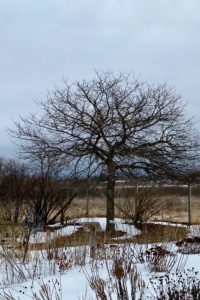
So, one of my greatest joys is tree planting. At least, when successful. There is no guarantee. If I have chosen a place with suitable soil, moisture, and sunshine for the tree species I’ve selected, and I protect it from browsing animals, the tree may have a chance. There are no guarantees, and I’ve planted enough trees in what I thought were suitable spots which failed to thrive or just plain died for reasons I didn’t know. In that case persistence, or stubbornness is the only option. You try again until you get it right.
And what trees to plant? It depends on your goals. Appearance, food, and wildlife value are all good reasons to plant trees, and there are hundreds of species to choose from. My interest is in wildlife, so first I look for trees native to this area. The number of species isn’t limiting to that, but availability of native species is. As with many things, we are drawn to the novel and flashy. Foreign trees are often that, and we generally latch onto them- blue spruce, Norway maple, and many others are purchased and planted in large numbers. Some become invasive pests like common and glossy buckthorn. Why? because they aren’t from here, and there is nothing in our natural world to interact with or control them. Deer and other animals don’t browse on them, but birds do eat their fruit and spread their seeds throughout the forest. There, their seedlings grow unmolested and eventually crowd out the native plants. What’s left is a very undesirable woods overcrowded with dense stands of thorny trees, not good for most wildlife.
It is possible to determine which are the best, however. If one wants to help birds, well, they all need insects to feed on. If one wants to help game, nuts are an excellent food item for many. Which trees best provide a combination of both? Oaks. White oaks in particular. This has been pointed out by Prof. Douglas Tallamy of the University of Delaware. He is an entomologist and studies the relationships between insects and plants, and points out that more than 500 insects, many of them caterpillars, feed on oaks. Not that they kill the trees- oaks are tough and have ways to tolerate the insect feasting. Also, many if not most songbirds eat caterpillars and feed them to their young. They are a preferred food because they are very nutritious and so ideal for baby birds. And in turn, the birds help the oak trees by removing caterpillars so the trees aren’t munched to death. Its a relationship that has developed over millions of years. At the same time, oaks produce nuts which feed many other wildlife species from birds to many mammals. White oak acorns are the most preferred, more than those of red oaks. Considering that it takes 6,000-9,000 caterpillars to feed a nest of chickadee chicks, trees like oaks are extremely important.
In second place are willow, which support more than 300 different insects, including some of our most beautiful butterflies like the tiger swallowtail. Although they don’t have pretty flowers, willow catkins provide an early pollen source for many bees and other important pollinators, which help pollinate the willows also. Willows also produce ample leaves for browsing animals, and tiny, fluffy seeds which can be used to line a bird’s nest. The trees are not as strong as oaks, so may not be suitable for home yard use, but if growing on wild land should be left to help wildlife.
If we can provide a landscape where we live that is 70% native plants, wildlife and ultimately our own lives can be sustained. We can have 30% non-native plants around if we like, as long as they are not ones that escape and become invasive. It’s easy to tell which ones those are.
So if you have space or need to replace a tree, consider planting an oak. For much of our area, even in wetter spots, white oak, swamp white oak, and bur oak are excellent, strong trees which beautify our yards and make them friendly for birds and other wildlife. If on dry ground, red oak will grow. Even the smallest planting effort helps.
photo- a 20 year old swamp white oak in the butterfly garden at Woodland Dunes
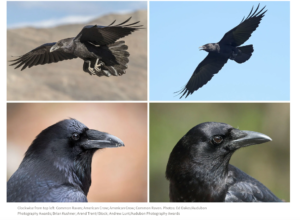 Mostly, ravens are found in northern Wisconsin, nesting on rocky cliffs or in tall pine trees. Their rough, croaking call is much different from the caws of American crows, and hearing them reminds me of my favorite times in places like the Boundary Waters or the UP of Michigan. They are significantly larger than crows, although if the two are not seen together it’s not always obvious. The ends of both their bodies give them away, however. Their beaks are massive, much larger and heavier than a crow’s and their tails are diamond-shaped at the trailing end, unlike the square tails of crows.
Mostly, ravens are found in northern Wisconsin, nesting on rocky cliffs or in tall pine trees. Their rough, croaking call is much different from the caws of American crows, and hearing them reminds me of my favorite times in places like the Boundary Waters or the UP of Michigan. They are significantly larger than crows, although if the two are not seen together it’s not always obvious. The ends of both their bodies give them away, however. Their beaks are massive, much larger and heavier than a crow’s and their tails are diamond-shaped at the trailing end, unlike the square tails of crows. 

